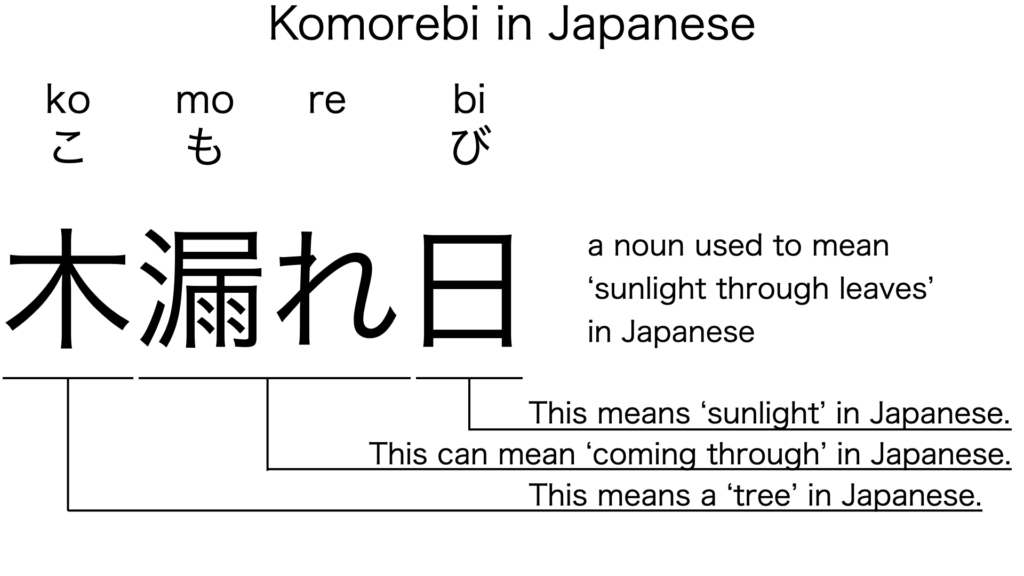What does “komorebi” mean in Japanese?
Native speakers use komorebi to mean ‘sunlight through leaves’ in Japanese. Perhaps, some Japanese learners know this word as it is sometimes used in Japanese movies, songs, novels, manga, anime, and the like. In this blog post, however, I’m explaining this word in detail based on its kanji expression. And also, I’m explaining how to use it through example sentences. My explanations would help Japanese learners understand komorebi more clearly. Then, let’s get started!
Contents
Definition and meaning of “komorebi”
Let me start with the definition and meaning of komorebi.
- komorebi – 木漏れ日 (こもれび) : a noun used to mean ‘sunlight through leaves’ in Japanese.
The definition and meaning are simple and clear. To understand this noun more clearly, however, let me explain its kanji expression in detail.
Komorebi in kanji
The kanji expression of komorebi consists of the following three parts:
- ko – 木 (こ) : a noun used to mean a ‘tree’ in Japanese.
- more – 漏れ (もれ) : can be considered as the noun form of the verb, moreru, which means ‘to spill’, ‘to leak’, ‘to come through’, or such in Japanese.
- bi – 日 (び) : a noun used to mean ‘sunlight’, ‘sun’, or ‘day’ in Japanese.
From these three parts, we can understand that komorebi literally means ‘sunlight coming through trees’ in Japanese. This literal interpretation is very close to the actual meaning.

When we meet new kanji expressions, we should check their kanji characters in detail to understand their meanings clearly and deeply. In many cases, kanji characters tell us a lot about the meanings of the expressions they form. Actually, here, we could get the better understanding of komorebi through the detailed kanji check above.
So far, I’ve explained the definition and meaning of komorebi together with its kanji characters. Then, let me explain how to use it through the example sentences below.
How to say “sunlight through leaves” in Japanese
nihonjin wa komorebi ga suki desu – 日本人は木漏れ日が好きです (にほんじんはこもれびがすきです)
Japanese people love sunlight through leaves.
Below are the new words used in the example sentences.
- nihonjin – 日本人 (にほんじん) : a noun used to mean a ‘Japanese person’ or ‘Japanese people’ in Japanese.
- wa – は : a binding particle working as a case marker or topic marker. In the example, this works after nihonjin to make the subject in the sentence.
- ga – が : a case particle used to make the subject word or the object word in a sentence. In the example, this is used after komorebi to make the object in the sentence.
- suki – 好き (すき) : the stem part of the na-adjective, sukina, which means ‘favorite’ in Japanese. Native speakers, however, often use this as an individual word to mean ‘to like’ or ‘to love’ in Japanese. In the example, this is used to mean ‘to love’ in Japanese.
- desu – です : an auxiliary verb used after a noun or adjective to make it polite. Probably, this is well known as a part of the Japanese desu form. In the example, this is used after suki to make it sound polite.
This is a typical usage of komorebi. In this example, it works together with the case particle, ga, to become the object in the sentence.
Another example of “komorebi”
komorebi wa totemo utsukushiku mieru – 木漏れ日はとても美しく見える (こもれびはとてもうつくしくみえる)
Sunlight through leaves looks very beautiful.
Below are the new words used in the example sentence.
- totemo – とても : an adverb of degree used to mean ‘very’, ‘much’, ‘so’, or such in Japanese. In the example, this is used before utsukushiku to emphasize its meaning.
- utsukushiku – 美しく (うつくしく) : one conjugation of the i-adjective, utsukushii, which means ‘beautiful’ in Japanese. In the example, it has been conjugated for the better connection with its following word.
- mieru – 見える (みえる) : a potential verb used to mean ‘can see’, ‘can watch’, ‘can look’, or such in Japanese. In the example, this is used together with utsukushiku to mean ‘to look beautiful’ in Japanese.
This is another example of komorebi. In this example, it works together with the binding particle, wa, to become the subject in the sentence. When we want to mean ‘sunlight through leaves’ in Japanese, anyway, this noun is always a very good option.
Summary
In this blog post, I’ve explained the definition and meaning of komorebi in detail based on its kanji expression. And also, I’ve explained how to use it through the example sentences. Let me summarize them as follows.
- komorebi – 木漏れ日 (こもれび) : a noun used to mean ‘sunlight through leaves’ in Japanese. This kanji expression literally means ‘sunlight coming through trees’ in Japanese. This literal interpretation is very close to the actual meaning.
Hope my explanations are understandable and helpful for Japanese learners.
Leave a Reply